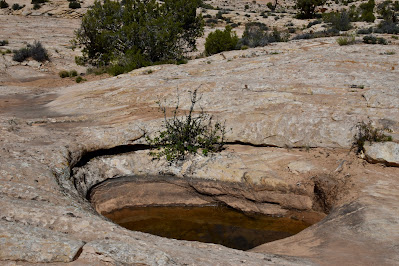A day!
Magically (well, after some preparation, packing & a few hours of driving), we awaken one morning in the teeny tiny Wolf Pup in amazing Bluff, Utah, surrounded by some of the most stunning landscape on Earth. Landscape that, of course, I want to photograph to share; however, there was that issue of dust particles in the camera. It is amazing how huge those tiny bits appear when they show up on a picture.
How those particles ensconced themselves inside my camera is a mystery. Unfortunately, there was no time to have it cleaned, which led the señor to an online search for a solution. Turns out there was hope, temporary at least, with dust-disappearing software. Mind you, the fix-it process took up a whole bunch of our first day out and was too late for that day's pics - wah! I couldn't give them up after the trek it took to get them, so more time was involved with manual clean-up after the fact.
The dust-be-gone process required updating computer operating systems, up- (or is it down-) loading software, and much more in the technology ilk (more wah! with an argh! thrown in).
Bowing to reality, we slogged through what was demanded of us, albeit abandoning the computer to do its thing whilst we hied ourselves away to do what we went there to do. In the end, the first day's photos, while requiring extra work to clean up, came out okay.
Comb Ridge, Double Stack . . .
. . . is in itself a gargantuan and gorgeous landscape feature, one of my favorite places. A seemingly impenetrable impediment for Mormon pioneers who were bound for additional sites to settle, the 80-mile-long rock uplift along Butler Wash has within its niches and canyons many prehistoric cliff dwellings. We have visited some, and determined to check out more: Double stack ruins was our destination for one day.
As we drove out one of many ochre-hued roads thereabout, we marveled as always at the beauty around us. A very wet and cold winter has deposited heavy snowpack on surrounding mountains ranges - the Abajos, Navajo Mountain, Sleeping Ute, and the Henrys (the last range in the lower 48 to be explored).
The so-called "easy" hike required crossing the many drainages that break up the land, so there was plenty of climbing down into those dry washes, thus climbing back up the other side. Some of that was pretty steep, but I managed with a bit of extra oomph.
Most of Utah is sparsely settled, said to contain more lizards than humans; indeed, our trek proved that out.
The slickrock is pocked with depressions that hold water for varying lengths of time, depending on location and depth.
As we made upward progress, we found awesome views until we were within the canyon walls.
Along the way . . . possibly the remains of a historic Ute shelter, opines my pard.
The ruin itself was tucked into a south-facing rock alcove and was quite interesting, although its stage of deterioration seems to put it in danger of more collapse.
A few artifacts and corncobs were present, in addition to numerous paint handprints, red, white & orange. I saw only one that was in the negative, i.e. with the paint blown around the perimeter.
Presumably the reason for the place being dubbed "Double Stack" is a separate large unique structure in a much-higher rock niche. Following a try at reaching that higher ruin via a way-too-scary rock ledge, we satisfied ourselves with examining it from below.
We were able to see the entire intact front and both ends, and saw only one small smokehole opening.
We had the place to ourselves except for a nice couple from Montana. Like normal people, when they had done with their explores of the ruin, they climbed back out of the canyon, but like not-normal people, we opted to peruse whatever we might find further up the canyon.
There was one small water seep, and another rock overhang - huge and stunningly decorated by nature's paintbrush. The place was probably large enough to hold five houses, deep and wide, but we saw no pictographs or artifacts there.
We climbed up onto a mid-canyon knoll that allowed us a better look at the higher structure and down onto the lower one,
Our upward progress continued right up until we met the box wall that is a feature of Comb Ridge and a narrow cleft choked with enough vegetation to deter us from further advancement even if we had been inclined to climb the wall beyond, which we were most decidedly not.
It is always amazing to me how vegetation thrives in conditions that seem so inhospitable - rocky, sandy, and with little light or water.
The San Juan & a taste of home . . .
A few more back road explores brought us to abrupt drop-off bluffs at the San Juan River, overlooks but without access.
Further on, at Sand Island, we walked to the water's edge to check out the flow, much increased by the winter's precipitation. . .
. . . and what were the chances that while we were admiring the San Juan, two Prescott College vehicles arrived!
When Chris introduced himself as Class of '71, he might as well have said he was a tyrannosaurus rex. The looks on their faces could not have been more surprised. Those kids' grandparents were probably not even born by then.
It was fun to have a short chat with them after that serendipity, and to find that they were a class of river guides in training.









































No comments:
Post a Comment